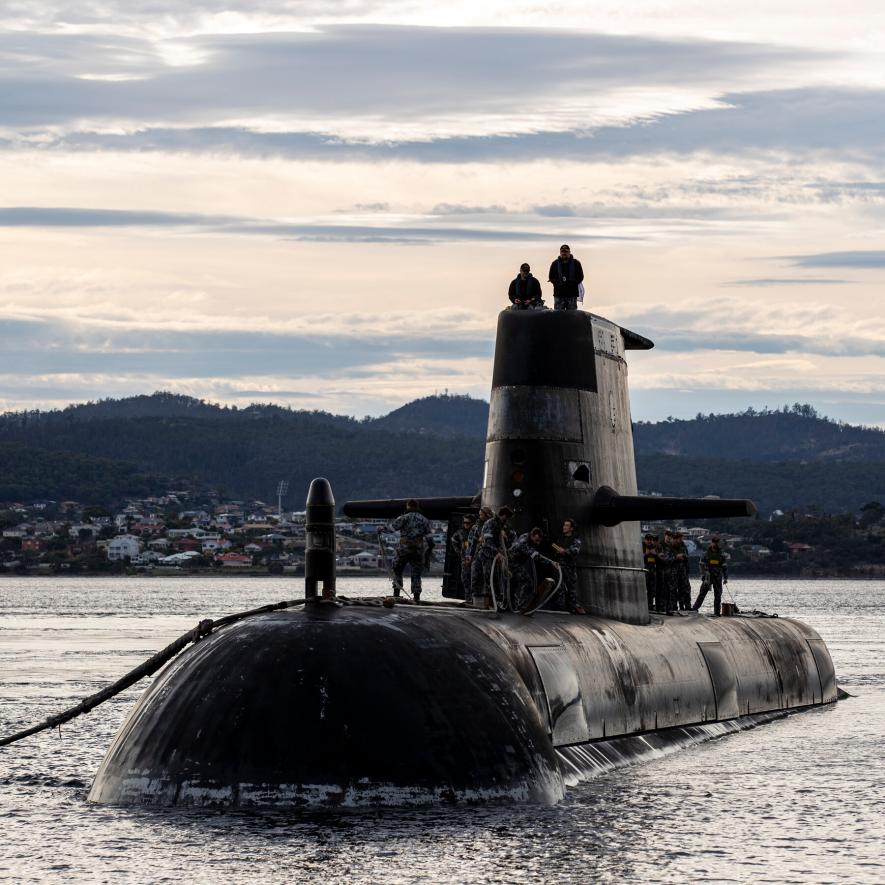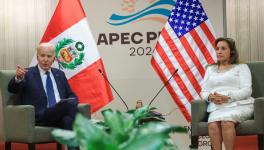AUKUS, Quad and India’s Losing the Plot Internationally

Image for representational purpose. Credit: The New York Times
The Quad leaders meeting at the White House on 24 September appears to have shifted focus away from its original framing as a security dialogue between four countries, the United States, India, Japan and Australia. Instead, the United States seems to be moving much closer to Australia as a strategic partner, providing nuclear submarines.
Supplying American nuclear submarines that use bomb-grade uranium violates the Nuclear Non-Proliferation Treaty (NPT) and International Atomic Energy Agency protocols. Considering the United States wants Iran not to enrich uranium beyond 3.67%, this is blowing a big hole in its so-called rule-based international order—unless the rule-based international order is essentially the United States and its allies making up all the rules.
Japanese Prime Minister Shinzo Abe had initiated the idea of the Quad in 2007 as a security dialogue. The statement issued after the first formal meeting of the Quad countries on 12 March 2021 used security in the sense of strategic security. Before the recent meeting of the Quad, both the United States and the Indian sides denied it was a military alliance, even though the Quad countries conduct joint naval exercises—the Malabar Exercise—and have signed various military agreements. The 24 September Quad Joint Statement focuses more on other “security” issues: health security, supply-chain and cyber-security.
Has India decided it still needs to retain strategic autonomy even if it has serious differences with China on its northern border and, therefore, stepped away from Quad as an Asian NATO? Or has the United States itself downgraded Quad, now that Australia has joined its geostrategic game of containing China?
Before the Quad meeting in Washington, the United States and the United Kingdom signed an agreement with Australia to supply eight nuclear submarines—the AUKUS agreement. Earlier, the United States had transferred nuclear submarine technology to the United Kingdom, and it may have some sub-contracting role here. Nuclear submarines, unlike diesel-powered submarines, are not meant for defensive purposes. They are for force-projection far away from home. Their ability to travel large distances and remain submerged for long periods makes them an effective strike weapon against other countries.
The AUKUS agreement means Australia is cancelling its earlier French contract to supply twelve diesel-powered submarines. The French are livid that they, one of NATO’s lynchpins, have been treated this way with no consultation by the United States or Australia on the cancellation. The United States administration has followed it up with “discreet disclosures” to the media and American think-tanks that the agreement to supply nuclear submarines also includes Australia providing naval and air bases. In other words, Australia is joining the United States and the United Kingdom in a military alliance in the “Indo-Pacific”.
Earlier, French President Emmanuel Macron was fully on board with the United States policy of containing China and participated in Freedom of Navigation exercises in the South China Sea. France had even offered its Pacific Island colonies—yes, France still has colonies—and its navy to the United States project to contain China in the Indo-Pacific. France has two sets of island chains in the Pacific Ocean that the United Nations terms as Non-Self-Governing Territories—colonies—giving France a vast Exclusive Economic Zone, second only to the United States. The United States considers these islands less strategically valuable than Australia and, therefore, we find it willing to face France’s anger. In the United States’ world-view, both NATO and the Quad are being downgraded for a new military strategy of a naval thrust against China.
Australia has very little manufacturing capacity. If the eight United States nuclear submarines are to be partially manufactured there, the infrastructure required to do this, and produce/handle the highly enriched uranium they use, will probably require at least twenty years. That is why the plan is for naval and air bases in Australia, with the United States providing the nuclear submarines and fighter-bomber aircraft, on lease or simply located in Australia.
I have previously argued that “Indo-Pacific” may make sense to the United States, the United Kingdom, even Australia, which are essentially maritime nations. The optics of three maritime powers, two settler-colonial and the third the erstwhile largest colonial power, talking about a rule-based international order does not appeal to most of the world. Oceans are important to maritime powers, who used their naval dominance to create colonies. It was the basis of the dominance of British, French and later, American imperial power. That is why they all have large aircraft carriers: they are naval powers and believe that the gunboat diplomacy they used to build their empires still works. The United States has 700-800 military bases worldwide: Russia less than ten; China three.
Behind the rhetoric about Indo-Pacific and ‘open seas’ is the United States play in Southeast Asia. Here, talk of the Indo-Pacific has little resonance for most people. Its main interest is in the Regional Comprehensive Economic Partnership (RCEP) spearheaded by ASEAN countries. Even with the United States and India walking out of RCEP negotiations, the fifteen-member trading block is the largest, with 30% of the global GDP and population. Two Quad partners—Japan and Australia—are in the RCEP.
The United States’ strategic vision is to project its maritime power against China and contest for control over even Chinese waters and economic zones. It is in the recently declassified 2018 US Pacific Strategy Doctrine that the United States put forward. This doctrine states its naval strategy is to deny China sustained air and sea dominance inside the first island chain and dominate all domains outside it. This document is a good education for those interested in how the United States views the Quad and India’s role in it.
The United States wants to use the disputes that Vietnam, the Philippines, Indonesia, Thailand, or Malaysia have with China over the boundaries of their exclusive economic zones. While some of them may look to the United States for support, none of these Southeast Asian countries supports the American interpretation of Freedom of Navigation, under which it carries out its FONOPS or Freedom of Navigation Operations. As India found at its own cost in Lakshadweep, how the United States defines freedom of navigation does not square with its definition of Freedom of Navigation either. For all its talk about rule-based world order, the United States has not signed the United Nations Convention on the Law of the Sea (UNCLOS). So, when India and other partners of the United States sign on to American Freedom of Navigation statements, they are signing into an understanding of freedom of navigation that is at variance with theirs.
The 1973 NPT created two classes of countries, ones that would be allowed to a set of technologies that could lead to bomb-grade uranium or plutonium and others who would get denied those technologies. There was, however, a submarine loophole in the NPT and its complementary International Atomic Energy Agency, or IAEA, Safeguards for the peaceful use of atomic energy. Under the NPT, non-nuclear-weapon state parties must place all nuclear materials under IAEA safeguards, except nuclear materials meant for nonexplosive military purposes. No country, until now, has utilised this submarine loophole to withdraw weapons-grade uranium from safeguards. If Australia uses this exception, how will the United States continue to argue against Iran’s right to enrich uranium, say, for nuclear submarines, which is within its right to develop under the NPT?
India was never a signatory to the NPT and, therefore, is a different case than Australia. If Australia, a signatory, is allowed to use the submarine loophole, what prevents other countries from doing so?
Australia did not have to travel this route if it wanted nuclear submarines. The French submarines they were buying were originally nuclear submarines that used low enriched uranium. France is retrofitting diesel engines, which has delayed its supplies to Australia. It appears, led by the current Prime Minister Scott Morrison, Australia wants to flex its muscles in the neighbourhood and has, therefore, tied up with Big Brother.
If for the United States, Southeast Asia is the terrain of struggle against China, Australia is a very useful springboard for conducting that struggle. It substantiates what we have said all along: the Indo-Pacific is only a cover for a geostrategic competition between the United States and China over Southeast Asia. Unfortunately for the United States, East and Southeast Asia have reciprocal economic interests that bring them closer. Australia, with a brutal settler-colonial past of genocide and neo-colonial interventions in Southeast Asia, is not seen as a natural partner in these countries.
India under Narendra Modi seems to have lost the plot completely. Does it want strategic autonomy, as was its post-independence policy? Or does it want to tie itself to a waning imperial power, the United States? The first gave it respect well beyond its economic or military clout. The current path looks more and more like a path towards losing its stature as an independent player.
Get the latest reports & analysis with people's perspective on Protests, movements & deep analytical videos, discussions of the current affairs in your Telegram app. Subscribe to NewsClick's Telegram channel & get Real-Time updates on stories, as they get published on our website.
























